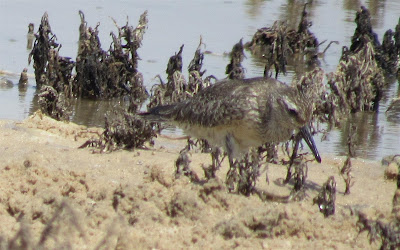After 15 months here, I always have target species in my mind before visiting a site in Mauritania. This time it was little gull, common gull, roseate tern or arctic tern among the hundreds of expected seabirds.
None of the targets were actually seen.
Instead things took a different twist almost on arrival. I thought I could see very distant birds of prey on some isolated sea cliffs a kilometre away. We made a detour towards them rather than head out to the start of the sea inlet as planned.
griffon vulture
They turned out to be six griffon vulture. The species is quite regular down the Mauritanian coast in winter as far south as Banc d'Arguin. However they were my first in the country.
griffon vulture flying
After a good look at the vultures, walking back up the beach towards the inlet but directly facing the sun, we managed to pick out a group of oystercatcher. There were great white pelican near-by too.
oystercatcher
The front end of the inlet was packed with birds.
greater flamingo
We didn't spend much time on the hundreds of lesser black backed gull, lesser numbers of black headed gull and tens of greater flamingo other than to look out for exceptions.
first grey-hooded gull
The exceptions we found were not the targets previously mentioned. Though there were two grey-hooded gull.
second grey-hooded gull
These are not western palearctic records as far as I understand it. I have seen several reports from Nouadhibou where European visitors are claiming records for the Western Palearctic. I have revisited Beaman et al's book which people use for the boundary. It says Mauritania north of the 21st parallel is in and maritime Banc d'Arguin is also in. Just because the peninsula containing Noudhibou is split down the middle with Western Sahara does not make Nouadhibou in. Nouadibou is only 20.5 degrees north. I'ts just tough luck that this inlet is less than 1 kilometre from Western Sahara.
I have seen some of the best birders in the wolrd claim Western Palearctic records from Cansado for example. It is a suburb of Nouadhibou and 500 metres from Western Sahara in places but it is out.
grey plover
I tried to photograph some of the less numerous birds in the bay. These included five grey plover and a single red knot.
red knot
There was also a single collared pratincole. As often is the case, this one was tame.
collared pratincole
The shear numbers of three types of tern were remarkable.
Caspian tern
Caspian tern were the largest and most imposing.
Sandwich tern was the second tern.
all common tern
I spent a long time shifting through the common tern looking for an arctic tern or roseate tern but with no success. To make things quicker I looked hard for rings which virtually every western European roseate tern has been given.
Even in temperate Nouadhibou, early afternoon can be hot. We headed back to the car for a short break.
great white pelican
The great white pelican were right in front of my return walk. Behind them were the cliffs holding the griffon vulture.
flying great white pelican
After our break and in late afternoon, we went to Cansado. The results were good. I will blog about this next.
Species seen in the central inlet, Nouadhibou
Greater Flamingo
Great White Pelican
Grey Heron (Grey)
Great White Egret
Western Reef-Heron
Eurasian Spoonbill
Egyptian Vulture
Griffon Vulture
Western Marsh Harrier
Eurasian Oystercatcher
Grey Plover
Kentish Plover
Common Ringed Plover
Whimbrel
Bar-tailed Godwit
Ruddy Turnstone
Red Knot
Sanderling
Dunlin
Collared Pratincole
Slender-billed Gull
Grey-hooded Gull
Black-headed Gull
Yellow-legged Gull
Lesser Black-backed Gull
Caspian Tern
Common Tern
Sandwich Tern
Common Redstart
Western Yellow Wagtail
White Wagtail
Tawny Pipit
Tree Pipit
Ortolan Bunting














No comments:
Post a Comment